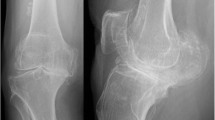Abstract
Introduction
Post-cam dislocation in TKA is a rare complication after posterior stabilized TKA.
Purpose
Four cases of posterior dislocation of the tibia relative to the femur are described in one current posterior stabilized design.
Conclusion
Specific design features in one contemporary high flexion TKA design contribute to high dislocation rates.


Similar content being viewed by others
References
Cohen B, Constant CR (1992) Subluxation of the posterior stabilized total knee arthroplasty. A report of two cases. J Arthroplasty 7:161–163
Jeffcote B, Nicholls R, Schirm A, Kuster MS (2007) The variation in medial and lateral ligament strain and tibiofemoral forces following changes in the flexion and extension gaps in total knee replacement. J Bone Joint (Br) 89 B:1528–1533
Lombardi AV, Mallory TH, Vaughn BK, Krugel R, Honkala TK, Sorscher M, Kolczun M (1993) Dislocation following primary posterior-stabilised total knee arthroplasty. J Arthroplasty 8:633–639
Morra EA, Rosca M, Greenwald J FI, Greenwald AS (2008) The influence of contemporary knee design on high flexion: a kinematic comparison with the normal knee. J Bone Joint (Am) 90:195–201
Pietsch M, Hofmann S (2007) From tibiofemoral instability to dislocation in total knee arthroplasty. Orthopade 36:917–922
Ries MD (2007) Effect of ACL sacrifice, retention, or substitution on kinematics after TKA. Orthopedics 30:74–76
Stukenborg-Colsman C, Wirth CJ (2000) Knee endoprosthesis: clinical aspects. Orthopade 29:732–738
Sharkey PF, Hozack WJ, Booth RE, Balderston RA, Rothman RH (1992) Posterior dislocation of total knee arthroplasty. Clin Orhop Rel Res 278:128–133
Victor J, Bellemans J (2006) Physiologic kinematics as a concept for better flexion in TKA. Clin Orthop Relat Res 452:53–58
Victor J, Mueller JK, Komistek RD, Sharma A, Nadaud MC, Bellemans J (2010) In vivo kinematics after a cruciate-substituting TKA. Clin Orthop Relat Res 468:807–814
Victor J, Van Glabbeek F, Vander Sloten J, Parizel PM, Somville J, Bellemans J (2009) An experimental model for kinematic analysis of the knee. J Bone Joint (Am) 91:150–163
Victor J. et al. (2009) Doctoral dissertation. A comparative study on the biomechanics of the native human knee joint and total knee arthroplasty. KUL:135–137. https://lirias.kuleuven.be/handle/123456789/233948
Author information
Authors and Affiliations
Corresponding author
Rights and permissions
About this article
Cite this article
Arnout, N., Vandenneucker, H. & Bellemans, J. Posterior dislocation in total knee replacement: a price for deep flexion?. Knee Surg Sports Traumatol Arthrosc 19, 911–913 (2011). https://doi.org/10.1007/s00167-010-1258-2
Received:
Accepted:
Published:
Issue Date:
DOI: https://doi.org/10.1007/s00167-010-1258-2



